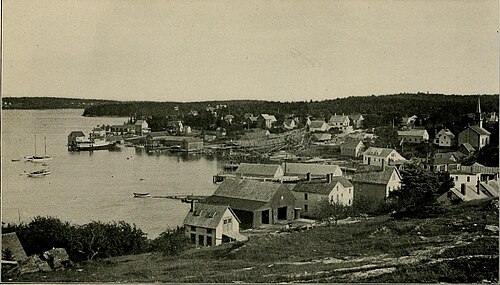
Maine, the northeasternmost state in the United States, boasts a long and storied past shaped by its rugged coastlines, dense forests, and the cultural intersections of Native American, French, English, and later American influences. Originally inhabited by tribes of the Wabanaki Confederacy, Maine’s strategic location along the Atlantic seaboard made it a focal point for early exploration and colonial rivalries. Over the centuries, Maine transitioned from a contested colonial territory to a proud participant in the American Revolution and, eventually, to statehood in 1820. This timeline offers a concise yet comprehensive look at the people, events, and milestones that have defined Maine’s history.
Research your ancestors on MyHeritage
Pre-Colonial and Early Exploration (Before 1600)Pre-Colonial and Early Exploration (Before 1600)
- c. 10,000 BCE: Paleo-Indians inhabit the region soon after the retreat of the last Ice Age glaciers, laying the foundations for what would become Wabanaki homelands.
- Pre-1500s: The area that is now Maine is occupied by various Algonquian-speaking peoples, including the Penobscot, Passamaquoddy, Micmac, and Maliseet—collectively known as the Wabanaki Confederacy.
- 1524: Italian explorer Giovanni da Verrazzano, sailing under the French flag, explores parts of the North American coast, possibly catching sight of Maine’s shoreline.
17th Century: Early Settlements and Colonial Struggles17th Century: Early Settlements and Colonial Struggles
- 1604: French explorers, led by Pierre Dugua (Sieur de Mons) and Samuel de Champlain, establish a short-lived settlement on Saint Croix Island at the mouth of the St. Croix River (modern Maine–New Brunswick border).
- 1607: The Popham Colony (also known as the Sagadahoc Colony) is founded by English settlers at the mouth of the Kennebec River; it is abandoned after about a year.
- 1622: The Council for New England grants the territory of “Maine” (an English spelling possibly referencing the French province of Maine or the term “mainland”) to Sir Ferdinando Gorges and Captain John Mason.
- 1652: The Massachusetts Bay Colony extends its jurisdiction over parts of southern Maine, beginning the region’s long association with Massachusetts.
- 1675–1678 (King Philip’s War): Although primarily centered in southern New England, violence spreads into Maine, devastating Wabanaki communities and English settlements alike.
- 1677: Thomas Gorges sold his rights to Massachusetts, which became the Province of Maine.
- 1688–1697 (King William’s War): French and English forces, along with their respective Native allies, clash repeatedly in Maine. Border raids and retaliatory strikes disrupt settlement.
18th Century: Colonial Tensions and the Road to Revolution18th Century: Colonial Tensions and the Road to Revolution
- 1702–1713 (Queen Anne’s War): Continued French-English conflict affects Maine; Native American tribes attempt to maintain autonomy amidst colonial rivalries.
- 1722–1725 (Dummer’s War): Also known as Father Rale’s War, intensifies hostilities between Wabanaki tribes and New England colonists.
- 1744–1748 (King George’s War): Maine once again serves as a frontier battleground between the French, the English, and their respective Native allies.
- 1754–1763 (French and Indian War): The final major colonial conflict in North America; French influence in Maine wanes as England solidifies control.
- 1775: Early in the American Revolution, naval skirmishes occur off Machias (the “Battle of the Margaretta”), marking one of the first naval engagements of the war.
- 1779: District of Maine part of Massachusetts until 1820.
19th Century: From District of Massachusetts to Statehood19th Century: From District of Massachusetts to Statehood
- 1812–1815 (War of 1812): Coastal Maine endures British naval blockades and brief occupations; the war strains ties with the rest of Massachusetts.
- 1820: Maine enters the Union as the 23rd state on March 15, as part of the Missouri Compromise. It is formally separated from Massachusetts.
- 1838–1839 (Aroostook War): A bloodless boundary dispute with Britain over the Maine–New Brunswick border.
- 1842: The Webster–Ashburton Treaty[1] resolves the Maine–Canada border, ending the lingering dispute from the Aroostook War.
- 1851: Maine becomes the first state to enact Prohibition, banning the sale and manufacture of alcohol.
- 1855 (Portland Rum Riot): Tensions over Prohibition come to a head in Portland, resulting in violence and national debate over temperance laws.
- 1861–1865 (American Civil War): Maine contributes significantly to the Union cause. Notable leaders include General Joshua L. Chamberlain, hero of Gettysburg.
Late 19th to Early 20th Century: Industrial Growth and Social ChangeLate 19th to Early 20th Century: Industrial Growth and Social Change
- 1870s–1900: Maine’s lumber, shipbuilding, and fishing industries flourish; inland logging communities thrive along the Penobscot and Kennebec Rivers.
- 1880s: Tourism emerges, with wealthy families building grand “cottages” along the coast, particularly on Mount Desert Island (later Acadia National Park).
- 1919: Acadia National Park is formally established, preserving Maine’s pristine coastal landscapes.
- 1920s: The growth of paper mills and the continued expansion of railroads accelerate Maine’s industrial base, though the state remains largely rural.
Mid-20th Century: Wartime Contributions and Modern DevelopmentMid-20th Century: Wartime Contributions and Modern Development
- 1930s–1940s: The Great Depression affects Maine’s rural communities; New Deal programs help build infrastructure. Many mills folded or moved south. Many small towns and farms abandoned.
- 1941–1945 (World War II): Bath Iron Works and other shipyards bolster the war effort; Maine’s coastal ports are vital to the U.S. Navy.
- 1947 (Great Fires of 1947): Devastating fires sweep across Maine’s forests and communities, destroying homes and reshaping land management policies.
- 1950s–1960s: Postwar economic shifts lead to declines in traditional industries; many Mainers migrate to urban centers or out of state.
Late 20th Century to Present: Economic Diversification and PreservationLate 20th Century to Present: Economic Diversification and Preservation
- 1970s–1980s: Conservation efforts intensify; the state invests in preserving fisheries, forests, and cultural heritage sites.
- 1980: The Maine Indian Claims Settlement Act provides financial compensation and federal recognition of tribal lands, addressing long-standing disputes between the state and Wabanaki tribes.
- 1990s: Tourism continues to expand as a key economic driver; Maine’s lobster industry gains worldwide prominence.
References
- ↑ Webster-Ashburton Treaty, 1842. Milestones in the History of U.S. Foreign Relations.

